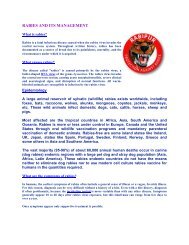Download Annual Report - Renata
Download Annual Report - Renata
Download Annual Report - Renata
Create successful ePaper yourself
Turn your PDF publications into a flip-book with our unique Google optimized e-Paper software.
2.10 Borrowing costThe company capitalizes borrowing cost for new projects such as interest on term loan and other related fees/charges for theperiod till to commencement of commercial operation and charges the cost to revenue account as financial expenses aftercommencement of the commercial operation.2.11 Earnings per share (EPS)The Company represents basic earnings per share (EPS) data for its ordinary shares. Basic EPS is calculated as the profitor loss attributable to the ordinary shareholders of the Company divided by the weighted average number of ordinary sharesoutstanding during the period.Diluted EPS is determined by adjusting the profit or loss attributable to ordinary shareholders and the weighted averagenumber of ordinary shares outstanding, for the affects of all dilutive potential ordinary shares. However, dilution of EPS is notapplicable for these financial statements as there was no potential dilutive ordinary shares during the relevant periods.2.12 Segment reportingAs there is a single business and geographic segment within which the company operates as such no segment reporting isfelt necessary.2.13 Financial Risk Management<strong>Renata</strong> Limited’s activities expose it to a variety of financial risks and those activities involve the analysis, evaluation,acceptance and management of some degree of risk or combination of risks. Taking risk is core to the financial business, andoperational risks are an inevitable consequence of being in business. <strong>Renata</strong> Limited’s aim is therefore to achieve anappropriate balance between risk and return and minimize potential adverse effects on <strong>Renata</strong> Limited’s financialperformance.<strong>Renata</strong> Limited’s risk management policies are designed to identify and analyse these risks, to set appropriate risk limits andcontrols, and to monitor the risks and adherence to limits by means of reliable and up-to-date information systems. <strong>Renata</strong>Limited regularly reviews its risk management policies and systems to reflect changes in markets, products and emergingbest practices.2.13.1 Credit riskCredit risk is the risk that counterparty will not meet its obligations under a financial instrument or customer contract, leadingto a financial loss. The Senior Management of <strong>Renata</strong> Limited carefully manages its exposure to credit risk. Credit exposuresarise principally in receivables from customers into <strong>Renata</strong> Limited’s asset portfolio. The credit risk management and controlare controlled through the credit policies of <strong>Renata</strong> Limited which are updated regularly. The company is also exposed toother credit risks arising from balances with banks which are controlled through board approved counterparty limits.2.13.2 Liquidity riskLiquidity risk is defined as the risk that the Company will not be able to settle or meet its obligations on time or at a reasonable price.The Company's approach to managing liquidity is to ensure, as far as possible, that it will always have sufficient liquidity tomeet its liabilities when due, under both normal and stressed conditions, without incurring unacceptable losses or riskingdamage to the Company's reputation. Typically, management ensures that it has sufficient cash and cash equivalent to meetexpected operational expenses, including the servicing of financial obligation through preparation of the cash forecast,prepared based on time line of payment of the financial obligation and accordingly arrange for sufficient liquidity/fund to makethe expected payment within due date..2.13.3 Market risk<strong>Renata</strong> Limited takes on exposure to market risks, which is the risk that the fair value or future cash flows of a financialinstrument will fluctuate because of changes in market prices. Market risks arise from open positions in interest rate andcurrency, all of which are exposed to general and specific market movements and changes in the level of volatility of marketrates or prices such as interest rates, credit spreads and foreign exchange rates.a. Currency riskThe company is exposed to currency risk on certain revenues and purchase such as revenue from foreign customersand import of raw material, machineries and equipment. The majority of the company’s foreign currency transactionsare denominated in USD and relate to procurement of raw material, machineries and equipment from abroad.b. Interest rate riskInterest rate risk is the risk that the future cash flows of a financial instrument will fluctuate because of changes inmarket interest rates. Fair value interest rate risk is the risk that the value of a financial instrument will fluctuatebecause of changes in market interest rates. <strong>Renata</strong> Limited takes on exposure to the effects of fluctuations in theprevailing levels of market interest rates on both its fair value and cash flow risks. Interest margins may increase as aresult of such changes but may reduce losses in the event that unexpected movements arise.•60



